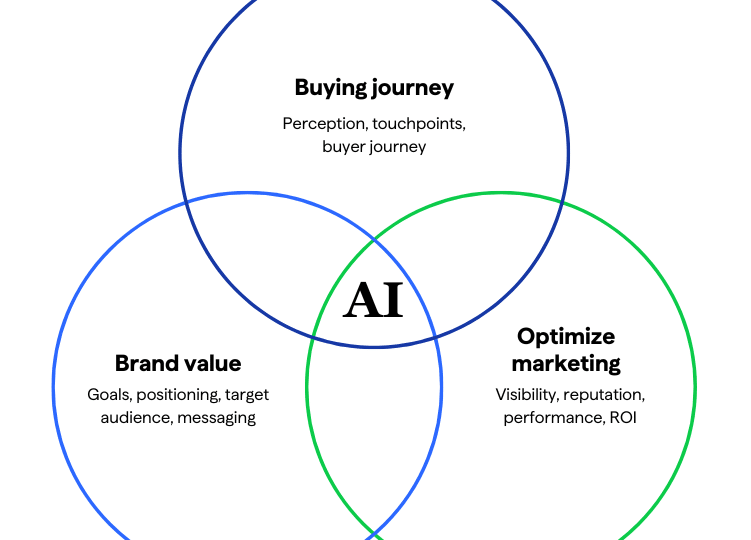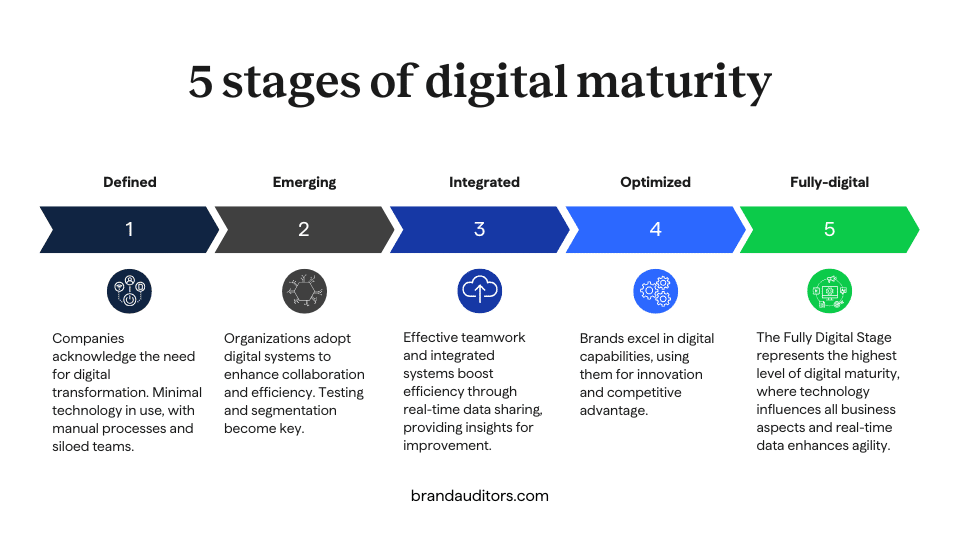AI Adoption Strategy for Small Business and Mid-Market Executives
How small businesses and mid-market companies can build a successful AI adoption strategy. Reduce risks and avoid common AI strategy mistakes.
October 20, 2025

Your competitors have started using artificial intelligence (AI). Your team is asking about it. Waiting isn’t an option, but you aren’t sure how or where to get started.
The last thing you want to do is waste time and money trying to implement AI technology.
The businesses getting real results aren’t smarter or more tech-savvy. They’re following a proven framework that starts with assessing their AI capabilities, starting with high-impact use cases, building in proper safeguards, and creating lasting momentum through structured scaling.
This post is for executives of small businesses and mid-market companies who want to develop a successful AI adoption strategy.
AI adoption: The two questions every business leader faces
When it comes to AI implementation, business leaders get stuck on two fundamental questions.
The first is:
“Where exactly should we implement AI to get real results?”
There are hundreds of possible use cases. Every vendor promises digital transformation. Every consultant has a different opinion. Too many choices create analysis paralysis.
And here’s the second question:
“How do we make sure AI adoption sticks after the first project?”
Most companies start with excitement. They run a pilot program. It works. Then, momentum dies. Teams drift back to familiar workflows. The automation tools gather dust.
These aren’t easy questions to answer. And the standard advice doesn’t help much. “Just start somewhere” or “build an AI strategy” sounds good but doesn’t tell you what to do Monday morning.

AI adoption challenges: Why most implementations fail
The statistics are sobering: 90% of AI projects fail to deliver ROI, and 60% fail outright. These findings show us howmany companies are struggling with wasted budgets, frustrated teams, and missed opportunities—all because they’re trying to adopt AI.
However, most organizations approach AI integration backwards. They start with what the technology can do, then try to make it fit into their organization. In other words, they’re forcing AI technology in the name of productivity and competitive advantage without know how Al will directly impact their business.
There’s no clear objective.
To make the situation more complex, add poor data quality, lack of organizational readiness, and inadequate risk assessment. Now, you have a recipe for failure.
It’s better to start small, prove value quickly, and build from there. Pick one high-impact use case where you can see results in weeks instead of months. Get a win, learn from it, and then expand.
3 high-impact AI use cases for AI technologies in business
In our experience working with clients to adopt AI, we have found three areas that consistently deliver strong ROI. These are practical solutions that work for small and mid-market businesses.
Content creation and marketing automation
This is often the best place for small businesses to start AI deployment. You can see results immediately, the risk is low, and the impact is measurable.
Think about how much time teams spend creating content. Sales proposals. Marketing emails. Product descriptions. Social media posts. Training documents. The list goes on.
AI-powered solutions can handle the first draft of almost all of this. Teams should still review and refine everything, but creation time gets cut by half or more.
Companies have reduced proposal development time from 8 hours to as little as 3 hours per proposal. Sales teams suddenly have time to actually sell instead of pushing paper.
The key is maintaining human oversight. AI creates the draft. People add the judgment, context, and final polish. This human-in-the-loop approach ensures quality control while still getting the productivity gains.
Customer intelligence
Companies sit on mountains of customer data. Support tickets. Survey responses. Sales calls. Reviews. Most of it never gets properly analyzed because nobody has time.
Business intelligence from AI changes this completely. Thousands of customer interactions can be analyzed in minutes. Patterns emerge that would never be spotted manually. The real drivers of customer retention or churn become clear.
Mid-market SaaS businesses have used predictive analytics to analyze customer support tickets from entire years. Common patterns reveal product issues that were never escalated. Fixing these recurring problems can reduce support volume by 20% and improve retention.
This kind of customer insight leads to data-driven decisions. Business leaders aren’t guessing anymore. They’re working with real intelligence about what customers actually think and need.
Customer service automation and support workflows
Some executives get nervous about using AI solutions in support roles because it’s customer-facing. But if it’s done well, it’s one of the highest-impact applications for operational efficiency.
The goal is not to replace support teams with chatbots. In fact, chatbots can annoy customers.
However, teams can become more effective using intelligent automation. AI systems can handle routine requests: answering common questions, routing tickets to the right person, pulling up relevant information, drafting responses for agents to review.
Teams focus on the complex issues that need human judgment. As a result, response times drop and customer satisfaction goes up. Your best reps stop burning out on repetitive work.
Organizations that automate tier-one support responses still provide real people for anything complex, but simple questions get answered instantly.
Average response times can drop from 4 hours to 15 minutes. Support teams find their jobs more interesting because they only handle the challenging cases.

A framework for successful AI adoption: Driving culture and momentum
Knowing where to start is half the battle. The other half is building an AI adoption framework that creates lasting organizational change.
Here’s what works.
Start with business problems, not AI solutions. Don’t start with AI technology. Instead, begin with a problem that’s costing you money or slowing you down. Map out your biggest operational inefficiencies. Quantify them if you can. Then ask whether AI might help solve them.
Invest in your people from day one. Technology alone doesn’t drive successful AI adoption—your team does. Identify internal champions who are excited about AI and can advocate for change.
Provide training and upskilling opportunities so employees understand how to work with AI tools. to accelerate AI adoption, people must feel empowered rather than threatened by new technology. Companies that invest in workforce readiness see adoption rates three times higher than those that focus solely on technology deployment.
Build guardrails from day one. Build review processes into your AI adoption strategy. Decide who checks the AI’s work. Create clear escalation protocols about what needs human approval. Set up quality metrics you’ll track and consider data security and compliance upfront.
Move in phases with structured scaling. Don’t try to transform your whole company at once. Start with 2-3 people using AI for one specific task. Run that proof of concept for 30 days.
Gather feedback and fix what’s broken. Then expand to a larger team for 60 days. Once you’ve tested your strategy, you can roll it out across the entire company. Each phase builds on what you learned in the last one.
Measure what matters. Track the key performance indicators that actually affect your business:
- Time savings (hours per week per person)
- Quality improvements (fewer errors, more consistency)
- Cost reduction (labor savings, efficiency gains)
- Adoption rates (are people actually using it?)
A practical example: Mid-market B2B companies are increasingly adopting AI-assisted content generation for sales operations. Early results show that reps can save up to 15 hours per week, and proposal turnaround times may improve by 20–30% within the first month, depending on workflow integration and tool maturity.
Success like this creates organizational momentum. Sales teams become internal advocates. Other departments ask to try automation tools. Within six months, companies have AI working in three departments with clear ROI at each step.

The cost of not having an AI strategy
Every month you wait, your competitors are moving forward. The best talent expects to work with modern digital tools. Customers expect faster, better service.
Here are just a few findings from early studies:
- McKinsey’s 2025 report “Superagency in the Workplace” estimates that AI could unlock $4.4 trillion in productivity gains across corporate use cases.
- Companies that reach AI maturity where AI is deeply embedded in workflows see substantial business outcomes, while those lagging in leadership and integration struggle to realize short-term returns.
- The report warns that companies failing to adopt AI strategically may become uncompetitive, echoing historical shifts like the rise of internet-era giants.
But rushing in without a plan creates bigger problems. A poorly implemented adoption strategy wastes money, frustrates your team, and can damage customer relationships.
The smart path forward is to start with high-impact, low-risk use cases. Get a win to build confidence, expand from there.
Do you need help with an AI adoption strategy?
If you’re running a company with at least $10 million in annual revenue and are not sure where or how to start using AI, you’re not alone.
The companies achieving business outcomes aren’t necessarily smarter or more tech-savvy. They just have a clearer technology roadmap for where to focus first.
The question isn’t whether to adopt AI. That decision has already been made by the market. The question now is how to implement it in a way that creates real value without creating new risks.
The companies that figure this out in the next 12 months will have a significant competitive advantage over those still planning and debating. Not because AI is magic, but because they’ll be operating more efficiently while their competitors are still stuck in analysis paralysis.
Ready to learn more?
Connect with a strategist for a no-obligation session designed to pinpoint your brand's biggest opportunities and get a clear path to successful outcomes.

POST AUTHOR
Core services
Digital marketing
audit services
Discover how to improve marketing campaigns, strengthen the impact of every customer touchpoint, and focus resources on the actions that generate more revenue.
Customer experience strategy consulting
Turn raw customer data into audience personas and laser-focused messaging.

